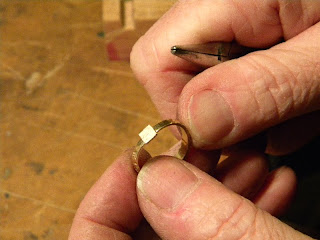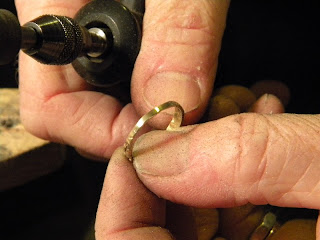Sizing a Ring
The following is a reasonable, if somewhat abbreviated, posting on what is involved in resizing a ring. The ring(s) in question are going up about two sizes, which means you need to add about 2/10ths of an inch of metal. If I was only going up a little I could probably just hammer the ring shank a little thinner, thereby stretching the rings' circumference a bit. But if you need to size a ring up more than a size you have to solder in a piece of matching metal, in this case gold. If you read the "Making an Ingot" posting you'll see in this posting, the small ingot being utilized in adding metal to the ring. I did not include very many pictures of me forming, filing, sanding, and buffing the ring. That sort of thing doesn't make for very interesting reading or pictures.
I've done a lot of ring sizing and learned ring sizing mostly, by practicing on silver rings. I used to do a lot of sizing and general jewelry repair for a gallery called, "Art at the Powerhouse" and really became pretty quick and adept at it over a period of years. I still do sizing for anybody that calls, stops by, or drops off rings and usually the price of sizing a silver ring up or down is between $10.00 and $20.00. Gold rings take a little more time but generally, size the same way, it just usually costs more.
_________________________________
This is the two rings I'll be using throughout this posting. They are made of14K gold, little diamonds on the one band and the other band is plain. The sculptural/carved nature of the rings will cause a problem by breaking during the sizing process. The carved grooves cut into the ring shank so far as to weaken the ring. I didn't show it in the pictures below, but I had to solder another piece of gold into the grooves and then re-file/carve the grooves to get everything to match back up. It was somewhat of a pain, but it came out OK. Things going wrong are just a part of the the process.
___________________________________
This is a picture of the plain band and some pictures of the gold I melted, poured into the charcoal mold, and then hammered and rolled. If you look at the post concerning "Making an Ingot "you'll see the step I did to prepare for this.
____________________________________
This is a shot of me cutting the ring apart to make way for the new piece of metal.
__________________________________
Pulling the band apart
____________________________________
In this picture I've slid the cut apart ring over the ring mandrel and am sliding the ring down until I get a little bit smaller than the size I want. Why a little smaller? Because later, after I've soldered the new piece of metal in, I'll need to form the metal with a hammer which will stretch the ring a bit larger.
__________________________________
Here, I'm using dividers to measure up for the metal to be soldered in. You could use a ruler, calipers, etc. to measure, dividers are just easier.
Here I'm transferring the measurement I took from above and am scratching it into the metal that will be used to solder into the ring.
_____________________________________
No big deal here, I'm just cutting the metal to size. I didn't get any photos of me filing the ring or the piece of metal about to be added to the ring. But both the ring and the metal have to be fitted carefully and exactly.
____________________________________
Setting the metal into the ring. Notice how the ring is not quite round anymore. It's more important that the ring and the piece of metal being used fit together perfectly, with no gaps. The ring can be made round later.
__________________________________
Her you can see the piece of metal fitted into the ring. There is a lot of excess metal but it makes it easier to fit and I can remove and form it later into the appropriate shape.
_____________________________________
Here you can see the ring slid over a tapered carbon/graphite rod (you can also get ceramic ones too)with the solder positioned over each joint. Here I'm using borax flux cause it holds stuff together a bit more than liquid flux, but you could use either one. You don't necessarily have to have the rod but it sometimes makes the process a little easier. In the picture right above you can see I'm packing a heat resistant gel around the ring that had the diamond setting to help protect the stones.
______________________________________
You can use any kind of torch to size as long as it get hot enough. I prefer a oxygen-acetylene torch for sizing, because it's very hot and allows me to heat the ring very quickly, without getting the stones hot. If done quickly, you can solder the ring with almost no heat getting to the setting. This takes practice because you can easily melt the ring shank and be back to square one. I've done it. Generally, silver conducts heat away quicker than gold and the shape of the item and the way you use the flame all contribute towards getting the project soldered right or melting into a frustrating mess.
_____________________________________
Here is the ring after the soldering. I've slid it onto a mandrel to round it back up and to start working it up to the size it should be.
_______________________________
A judicious amount of tapping will make it round and start to form the actual profile needed for the patch to match up with the profile of the ring itself.
_________________________________________
You can see where I've marked a line indicating where to cut to remove the excess material.
____________________________________
The extra is almost completely cut off.
____________________________________
Here is a picture of the ring with the excess metal removed. It looks 'kinda crude.
___________________________________
Some filing, both with hand files, sanding drums, and various tools is required to get the metal patch looking like it belongs. This process takes a bit of time, with various files and rotary bits.
__________________________________
Here, you can see the finished repair. If you fit and finish everything closely enough, you really can't see any signs of the repair.
___________________________________
Hopefully the above gives you an idea as to how to size a ring. There's undoubtedly more to it, but you get the general idea. Part of being able to size a ring is being able to fix things when you screw up. Which certainly happens on occasion. Getting a bunch of silver rings to practice on is a good idea. You'll melt a few and you need to get that out of the way(and learn how to fix your mistakes!) before you start doing it for paying customers.

























